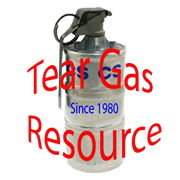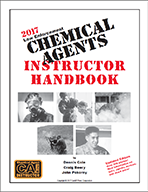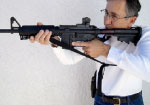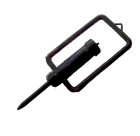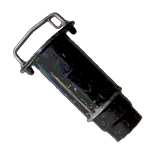Non-Lethal Chemical Agents as a Warrant Service Tool
“With a 15% increase in shooting deaths of law enforcement officers in 2012, …. Some police trainers are saying it is time for police to rethink their tactics, USA Today reported”.
“Some 68 law enforcers were killed by gunfire during 2011, 10 of them while serving search warrants or on multi-agency raids. While only three of them died doing work directly related to drug law enforcement -- two US Marshals were shot and killed in separate raids trying to arrest drug fugitives and one Florida police officer was killed trying to search suspicious persons for drugs. 105 officers were killed in 2013. (see stats)
"The days of knocking down doors in drug cases should be over. Given what's going on now, you have to consider other options," Pat McCarthy told USA Today. "Police should focus on trying to lure suspects out into the open or just "wait them out," he said. “It’s time to change our thinking, Cops are exposing themselves to increasing danger many times over, and it's just not necessary." stopthedrugwar
LETN teaches that a Breach-dynamic entry technique involves the age-old door breach followed by rapid clearance of the location. Proponents say it is expedient, efficient, and allows minimal potential for destruction of evidence. Opponents say the technique is little more than a court-authorized home invasion and the risks of forcing your way into the suspect’s stronghold generally outweigh the benefits.
Surround and callout: This technique involves covertly surrounding the target location, then using a telephone or public address system to call the occupants outside. Proponents say this is the overall safest method for everyone involved and dramatically reduces the potential for violent encounters. Opponents say this process allows the suspects to destroy evidence, procure weapons, and barricade themselves inside the structure if they were inclined to do so.
If we use the Surround and call out technique, or any technique, how can we protect the evidence we are searching for? One method is to deny the areas that could be used for evidence destruction from the suspects (Area Denial). The other is to divert the suspects away from evidence destruction (Diversion).
Diversion assists officers by taking further advantage of the suspect’s reaction time and draws his attention away from the officers point of entry and/or evidence destruction through physiological means (window smash at the rear of the house, telephone call at the moment of entry) or psychological means (the use of a noise flash diversionary device, non-lethal chemical agent insertion).
Area denial techniques work by either incapacitating or deterring the suspects. They are usually used in drug warrants to keep suspects from destroying evidence.
It should be understood that accidental, incidental, and correlative casualties are risked wherever force is applied, but Non-lethal Chemical Agents minimize the risk as much as possible.
Some area denial techniques commonly used in warrant services are:
- Shut down water supply to structure.
- Break toilets to prevent flushing.
- Station armed officers at windows to prevent suspect entry.
- Use Non-lethal Chemical Agents to contaminate area to deny suspect entry.
Non-lethal Chemical Agents used as area denial has been used by the military since the Vietnam War. It has only been used in law enforcement sporadically since then. Although Non-lethal Chemical Agents are very effective in denying entry into areas it has real problems ranging from political to financial.
Some of the issues:
- Political
- Courts
- Costs
- Personnel
- Availability
Any use of force occupies an influential place in political considerations. Non-lethal Chemical Agents in this circumstance may or may not be considered a use of force. If you use the definition of use of force that it is anything you do to make a person do something he may not want to do, then denying an area gives him an option not a forceful move. That use would not fit the definition of force.
However, if you use Non-lethal Chemical Agents from a distance without knowing who is in the area and you force a move by that person, it fits the technical definition of use of force.
So you must assume if you are using Non-lethal Chemical Agents as an area denial system in one room you will affect the entire structure. You generally cannot contaminate only one room of a structure.
Cross contamination in a neighborhood can also lead to political problems when it generates bad press coverage. This contamination can be controlled to some extent by the volume and type of agents deployed.
The San Diego Sheriff’s Department has used this technique in the past. Success when it was used was 100 percent. Suspects did not enter the areas that the Non-lethal chemical agents were applied to destroy evidence. It has only been used sporadically and not used as a regular technique because of all the political considerations mentioned above. There have been no claims or lawsuits against the agency for this technique.
Non-lethal Chemical Agents can be used legally in California for any purpose law enforcement chooses. This would include area denial.
Penal Code 22820. Nothing in this division prohibits any person who is a peace officer, as defined in Chapter 4.5 (commencing with Section 830) of Title 3 of Part 2, from purchasing, possessing, transporting, or using any tear gas or tear gas weapon if the person has satisfactorily completed a course of instruction approved by the Commission on Peace Officer Standards and Training in the use of tear gas.
Banks use Non-lethal Chemical Agents for robbery prevention by using systems that inject Non-lethal Chemical Agents into vaults. These systems take a permit from the State of California.
There are no cases from other agencies that have been reported in the press. An internet search has found no appellate court cases at any level. Lexus-nexus search has not been done.
If the technique has been used and a claim filed it would be up to the agency to investigate and recommend a settlement with the property owner. Many variables would apply to the outcome. Variables like; was dope found in the house, were the occupants the owners, level of damage and/or contamination, did the threat or amount of dope justify the potential damage, suspects potential for violence, etc.
If you are going to use this area denial technique you should have enough personnel trained in the use and deployment of Non-lethal Chemical Agents to carry it off successfully. Experience has shown that if you mix law enforcement personnel not familiar with the use of their respirators in stressful dangerous situation with those that are it leads to confusion and injury. Shooting with a respirator takes a skill not all officer’s possess.
The types of agent you have and the area that you want to deny will dictate what agents you can use. You should use an agent that will be effective but limit the contamination as much as possible. A gas plan should always be made complete with LCT50 times for the denied area. Different delivery methods have different issues.
Burning grenades are very persistent and would achieve the best denial area. The smoke is visible and tells a suspect to stay out or suffer the pain. Because they are so persistent the smoke will likely permeate the entire structure.
Blast grenades will release agent that will better stay in an area. They also can permeate an entire structure especially if a fan like forced air heating and cooling is operating in the area that you want to contaminate. However, the airborne particulate tend to settle to the ground more quickly. If a suspect comes into an area after the particulate has settled he will stir it up and get the effects then. Decontamination is usually easier than with a burning grenade.
Liquid aerosol or foam will settle out of the air almost immediately and would not work to deny and area to a suspect.
Types of agents available are generally CN, CS, and OC. All would be effective. The most common chemical used inside a structure is CS in the burning method of delivery. This is because of the airborne persistency and its ability to permeate an entire structure. This is also a drawback for area denial purposes. CS in a blast grenades would work a little better than OC because of the smaller particulate size making it easier to disturb and re-contaminate an area. However, OC in the powder form would be very effective.
CN is just not generally used anymore because it is not as effective as CS and OC.
